Odonata of Maludam National Park, Sarawak, Malaysia
Rory A. Dow 1, Robin Wen Jiang Ngiam 2 & Rambli Ahmad 3
1 Naturalis Biodiversity Center, P.O. Box 9517, 2300 RA Leiden, The Netherlands
2 National Biodiversity Centre, National Parks Board, 1 Cluny Road, Singapore 259569, Republic of Singapore
3vSarawak Forestry Corporation, Lot 218, KCLD, Jalan Tapang, Kota Sentosa, 93250 Kuching, Sarawak Malaysia
1 rory.dow230@yahoo.co.uk (corresponding author), 2 yanrobin@hotmail.com, 3 rambliahmad@sarawakforestry.com
Abstract: This paper presents records of Odonata collected in July 2012 in Maludam National Park, Sarawak, Malaysia. A total of 48 species from nine families were collected. Three species were new to science, one of which has already been described as Prodasineura yulan Dow & Ngiam, which may be endemic to Maludam. In addition, Maludam is only the second locality recorded in Sarawak for four poorly known species: Pachycypha aurea, Macrogomphus decemlineatus, Brachygonia ophelia and Brachygonia puella. Two of these species, Macrogomphus decemlineatus and Brachygonia ophelia, are recorded for the first time in Sarawak in more than 100 years
Keywords: Odonata, dragonflies, damselflies, Maludam, Betong, Sarawak, Malaysia, new species
Abstrak Bahasa Melayu: Kertas ini mengemukakan rekod Odonata yang dikumpul dalam bulan Julai di Taman Negara Maludam, Sarawak, Malaysia. Sejumlah 48 spesis daripada sembilan famili telah dikumpulkan. Tiga spesis adalah baharu kepada sains, satu daripadanya telah dihuraikan sebagai Prodasineura yulan Dow & Ngiam, yang mungkin endemik kepada Maludam. Tambahan pula, Maludam adalah tempat kedua di Sarawak yang merekodkan empat spesis yang kurang diketahui: Pachycypha aurea, Macrogomphus decemlineatus, Brachygonia ophelia and Brachygonia puella. Dua daripada spesis ini, Macrogomphus decemlineatus and Brachygonia ophelia, direkodkan untuk pertama kali di Sarawak dalam masa lebih daripada 100 tahun.
doi: http://dx.doi.org/10.11609/JoTT.o4107.6764-73 | ZooBank: urn:lsid:zoobank.org:pub:FD09ED0C-2C6F-47EE-91C7-1109C5DCF69D
Editor: Albert Orr, Griffith University, Nathan, Australia. Date of publication: 26 January 2015 (online & print)
Manuscript details: Ms # o4107 | Received 24 July 2014 | Final received 31 December 2014 | Finally accepted 04 January 2015
Citation: Dow, R.A., R.W.J. Ngiam, & R. Ahmad (2015). Odonata of Maludam National Park, Sarawak, Malaysia. Journal of Threatened Taxa 7(1): 6764–6773; http://dx.doi.org/10.11609/JoTT.o4107.6764-73
Copyright: © Dow et al. 2015. Creative Commons Attribution 4.0 International License. JoTT allows unrestricted use of this article in any medium, reproduction and distribution by providing adequate credit to the authors and the source of publication.
Funding: None.
Competing Interest: The authors declare no competing interests.
Author Details: Rory A. Dow is a research associate at Naturalis Biodiversity Centre, Leiden, the Netherlands. His research interests are in the faunistics and taxonomy of Asian Odonata. He has extensive experience of working in Southeast Asia, especially in Borneo. Robin Wen Jiang Ngiam works in the National Biodiversity Centre, Singapore. He is an Odonata expert in Singapore and has recently started to assist in Odonata research in Sarawak. Rambli Ahmad is an ecologist with the Sarawak Forestry Corporation.
Author Contribution: RAD identification and information on the Odonata collected, collection of specimens. RWJN collection of specimens and photography. RA background information and map in Figure 1.
Acknowledgements: The first two authors would like to thank the Sarawak Forestry Corporation and Sarawak Forest Department for granting permission to collect Odonata in Sarawak, the staff of Maludam National Park, in particular the park warden at the time of their visit, Toloy Keripin Munsang, for their assistance, and the people of Rumah Tanjong Baru for providing accommodation and hospitality. Albert Orr and two anonymous referees made comments on the paper that have greatly improved it. Special thanks are due to Watson Asai anak Jika and Mathew anak Samat for their assistance in the field.

INTRODUCTION
Peat swamp forests are waterlogged wetland areas, with very low levels of nutrient and dissolved oxygen. Peat swamp forest is a unique ecosystem where special flora and fauna have evolved and adapted to the seemingly harsh environment. More than 60% of the world’s tropical peat swamp forests are in Southeast Asia with the most extensive areas being in Borneo and Sumatra (UNDP 2006). Posa et al. (2011) demonstrated that a significant proportion of Southeast Asia’s vertebrate fauna can be found in peat swamp forests and that preservation of these forests is crucial in conserving a number of threatened taxa, especially specialized fish species. Peat swamp forests, however, are often regarded as unproductive wastelands, and suffer from anthropogenic impacts such as logging and conversion to agricultural use while receiving little attention from conservationists. The degradation and habitat loss of peat swamps in Southeast Asia over the last few decades has been unprecedented; it is estimated that only ca. 37% of historical peat swamp forest remains in the region (Posa et al. 2011).
Historically Sarawak and Sabah had ca. 17, 460km2 of peat swamp forest but only ca. 36% of it remains. Two of Sarawak’s longer established national parks contain significant areas of peat swamp forest: Loagan Bunut National Park in Miri Division, gazetted in 1990, and Maludam National Park in Betong Division, gazetted in 2000. Maludam National Park is about 43,147ha in size (Sarawak Forestry Corporation 2013). The park is located on the Maludam Peninsula and is part of the floodplain of the Lupar and Saribas rivers (Hazebroek & Morshidi 2000). Before the establishment of the park, the area was harvested for timber from 1955, mainly for ramin (Gonystylus bancanus - Thymelaeaceae) until logging concessions expired in 1999 (Wong 2003). Using remote sensing and GIS technology, Wong (2003) showed that natural undisturbed forests remaining in the national park constituted only about 3.29% of the total park area; much of the remaining area is still forested, with the forest in various states of disturbance.
Maludam National Park is a refuge for some of Sarawak’s most important animal populations. Examples are the Red-banded Langur Presbytis melalopos cruciger which is probably limited entirely to Maludam, the Borneo endemic Proboscis Monkey Nasalis larvatus and the rare Storm’s Stork Ciconia stormi (Hazebroek & Morshidi 2000). Odonata had not been surveyed in Maludam prior to 2012, indeed very little was known about the odonate fauna of Betong Division at all. There are only published records of eight species of Odonata that can be traced to Betong Division that we are aware of, all in Laidlaw (1914, 1920) and all from Saribas: Libellago hyalina (Selys, 1859); Rhinocypha cucullata Selys, 1873; Euphaea subcostalis Selys, 1873; Euphaea tricolor Selys, 1859; Elattoneura analis (Selys, 1860); Heliaeschna idae (Brauer, 1865); Gynacantha dohrni Krüger, 1899; and Microgomphus chelifer (Selys, 1858). It was against this background that a survey of the odonate fauna of Maludam National Park was conducted in July 2012 by the first two authors with assistance from the Protected Areas and Biodiversity Conservation Unit of the SFC.
MATERIALS AND METHODS
Adult Odonata were collected using handheld nets on six days from 6 to 11 July 2012. The main areas of collection were: Sungai Maludam near Rumah Tanjong Baru (outside the national park boundary); Sungai Maludam inside the national park, this is referred to below as Ulu (upriver) Maludam; in swamp adjacent to, and small streams flowing into Ulu Maludam (Images 1–3). On the Sungai Maludam, sampling was conducted from a boat. Sampling in swamp and small streams flowing into Sungai Maludam was conducted on foot. The sampling sites are shown in Fig. 1.
Specimens were preserved either by treatment with acetone or immersion in ethanol. The specimens are currently held in either the Naturalis Biodiversity Centre in Leiden, the Raffles Museum of Biodiversity Research at National University of Singapore, or the working collections of the first two authors.
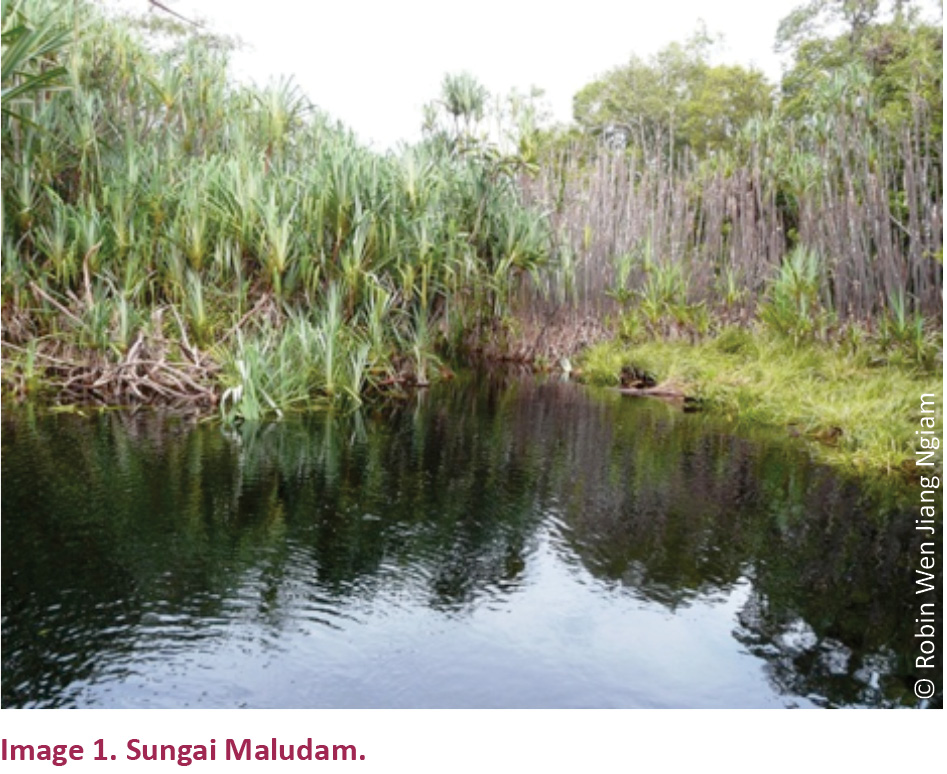
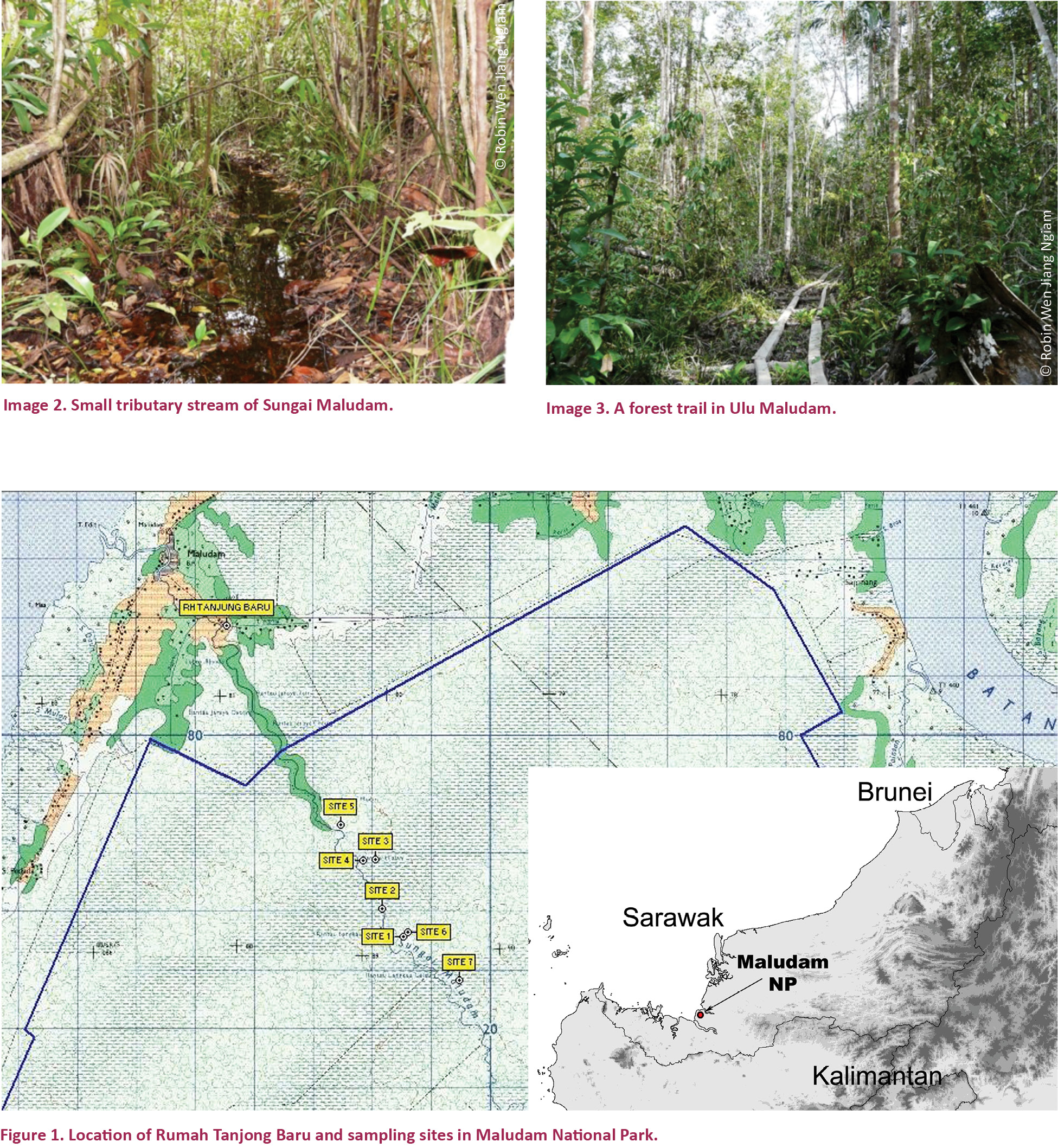
RESULTS
A total of 48 species from nine families were collected. Material listed is by date then in alphabetical order by collectors’ surname. Collectors: WA - Watson anak Asai; RD - Rory Dow; RN - Robin Ngiam. Classification follows Dijkstra et al. (2013) except that the Argiolestidae are recognized following Kalkman & Theischinger (2013) and Dijkstra et al. (2014).
Zygoptera
Argiolestidae
(i) Podolestes chrysopus Selys, 1889 (Image 4) — The only recent records of this species are from western Sarawak (Dow & Reels 2011; Dow 2012). It is otherwise known from locations in northwestern Kalimantan (Selys 1889; Lieftinck 1935); a record from Brunei (Thompson & van Tol 1993) in fact refers to misidentified P. harrissoni and that from Labuan in Selys (1889) is likely to be one of many cases where specimens were labelled according to the port from which they were sent back to Europe rather than collecting site. 4 males, 6.vii.2012, RD; 5 males, 7.vii.2012, RD; 1 male, 7.vii.2012, RN; 1 male, 1 female, 8.vii.2012, WA; 3 males, 1 female, 8.vii.2012, RN; 1 female, 9.vii.2012, WA; 1 male, 9.vii.2012, RD; 1 male, 9.vii.2012, RN; 1 female, 10.vii.2012, WA; 1 male, 1 female, 10.vii.2012, RD; 1 female, 10.vii.2012, RN; 1 male, 11.vii.2012, RD; 2 males, 11.vii.2012, RN.
(ii) Podolestes harrissoni Lieftinck, 1953 — Widely distributed across Sarawak and Brunei, but confined to peat swamp forest. 1 male, 6.vii.2012, RD; 9 males, 1 female, 7.vii.2012, RD; 3 males, 7.vii.2012, RN; 1 male, 9.vii.2012, WA; 1 male, 1 female, 9.vii.2012, RN; 1 male, 10.vii.2012, RD.
(iii) Podolestes orientalis Selys, 1862 — The most eurytopic and widespread of the Podolestes species, found in a variety of swampy situations. 1 female, 6.vii.2012, RN; 1 female, 7.vii.2012, RD; 2 males, 7.vii.2012, RN; 1 male, 10.vii.2012, RD.
(iv) Podolestes new species (Image 5) — Possibly the smallest Podolestes species known. Females were found perched at waist height in closed canopy forest without nearby free water. The sole male found was perched in a small hole dug into the damp peat, presumably by a Bearded Pig Sus barbatus, without free water; when disturbed it flew away but returned a few minutes later, and acted as if it was holding a territory at the hole. Water was only found ca. 15cm below the bottom of the hole. 2 females, 7.vii.2012, RD; 1 male, 10.vii.2012, RD.
Chlorocyphidae
(i) Libellago hyalina (Selys, 1859) — 2 males, 1 female, 6.vii.2012, RD; 1 male, 6.vii.2012, RN; 1 male, 1 female, 7.vii.2012, RD; 1 male, 7.vii.2012, RN; 1 female, 8.vii.2012, WA; 2 males, 9.vii.2012, WA; 2 males, 9.vii.2012, RD; 1 female, 10.vii.2012, WA; 1 male, 1 female, 11.vii.2012, RN.
(ii) Pachycypha aurea Lieftinck, 1950 — Maludam National Park is the second site in Sarawak where this poorly known species has been found, the other is a non-protected site near Kuching (Dow & Reels 2011); it is otherwise known from central Kalimantan. 1 male, 7.vii.2012, RN.
Platycnemididae
(i) Coeliccia species — The status of the Coeliccia species found at Maludam is still under investigation; it may merely be the widespread C. nigrohamata Laidlaw, 1918, which it closely resembles, but C. nigrohamata is not normally found in peat swamp forest. 1 male, 7.vii.2012, RD; 1 male, 9.vii.2012, RN; 1 male, 1 female, 10.vii.2012, RD.
(ii) “Elattoneura” aurantiaca (Selys, 1886) (Image 6) — See Dijkstra et al. (2014) for a discussion of Asian “Elattoneura”. 6 males, 1 female, 6.vii.2012, RD; 2 males, 6.vii.2012, RN; 1 male, 1 female, 7.vii.2012, RD; 2 males, 1 female, 7.vii.2012, RN; 1 female, 8.vii.2012, WA; 2 males, 1 female, 9.vii.2012, WA; 3 males, 1 female, 9.vii.2012, RD; 2 males, 9.vii.2012, RN; 1 male, 10.vii.2012, RN; 2 males, 1 female, 11.vii.2012, WA; 1 male, 2 females, 11.vi.2012, RN.
(iii) Onychargia atrocyana (Selys, 1865) — Onychargia was formerly placed in the Coenagrionidae, see Dijkstra et al. (2014). 1 male, 9.vii.2012, RD.
(iv) Prodasineura yulan Dow & Ngiam, 2013 — See Dow & Ngiam (2013).
Coenagrionidae
(i) Amphicnemis annae Lieftinck, 1940 — A peat swamp forest specialist, widely distributed in north-western Kalimantan, Sarawak and Brunei. 3 males, 1 female, 6.vii.2012, RD; 1 male, 3 females, 7.vii.2012, RD; 1 female, 9.vii.2012, RN; 3 males, 2 females, 10.vii.2012, RD; 1 male, 1 female, 10.vii.2012, RN; 1 male, 11.vii.2012, RD.
(ii) Amphicnemis wallacii Selys, 1863 — 1 male, 6.vii.2012, RD; 1 male, 9.vii.2012, WA; 1 male, 2 females, 9.vii.2012, RD; 1 male, 1 female, 9.vii.2012, RN; 3 males, 1 female, 10.vii.2012, RD; 1 male, 10.vii.2012, RN.
(iii) Amphicnemis species cf dactylostyla Lieftinck, 1953 — The status of forms allied to A. dactylostyla and A. martini Ris, 1911 in Sarawak is the subject of an on-going investigation. 3 males, 7.vii.2012, RD.
(iv) Archibasis melanocyana (Selys, 1877) — Abundant on stretches of Ulu Maludam. 1 male, 6.vii.2012, RD; 1 male, 6.vii.2012, RN; 3 males, 10.vii.2012, RD; 5 males, 1 female, 11.vii.2012, WA; 11 males, 11.vii.2012, RN.
(v) Archibasis viola Lieftinck, 1949 — 1 male, 6.vii.2012, RD; 1 male, 7.vii.2012, RD; 2 males, 1 female, 10.vii.2012, RD; 1 male, 10.vii.2012, RN.
(vi) Ceriagrion cerinorubellum (Brauer, 1865) — 1 male, 6.vii.2012, RN; 1 female, 8.vii.2012, RN; 1 male, 9.vii.2012, RD; 1 male, 1 female, 9.vii.2012, RN; 2 males, 10.vii.2012, WA; 1 male, 1 female (in tandem), 10.vii.2012, RN.
(vii) Ceriagrion new species — A species that closely resembles C. cerinorubellum, differing in the almost entirely red abdomen and details of the anal appendages. Since its discovery at Maludam it has also been found at two sites in Brunei (Ngiam, Dow & Choong in preparation). It appears to be a specialist of peat swamp and kerapa (intermediate between peat swamp and kerangas) forest. 1 male, 6.vii.2012, RD; 3 males, 7.vii.2012, RN; 2 males, 1 female(?), 8.vii.2012, RN; 1 male, 9.vii.2012, RD; 1 male, 10.vii.2012, WA; 2 males, 10.vii.2012, RD; 1 male, 10.vii.2012, RN.
(viii) Ischnura senegalensis (Rambur, 1842) — 1 male, 10.vii.2012, RD.
(ix) Mortonagrion indraneil Dow, 2011 — Like Podolestes harrisoni, this species is widely distributed in Sarawak and Brunei, but is confined to peat swamp forest. 1 male, 6.vii.2012, RD; 3 males, 2 females, 7.vii.2012, RD; 1 male, 7.vii.2012, RN; 1 male, 8.vii.2012, WA; 1 male, 9.vii.2012, RD; 1 female, 9.vii.2012, RN; 2 males, 1 female, 10.vii.2012, RD; 1 female, 10.vii.2012, RN.
(x) Pseudagrion coomansi Lieftinck, 1937 — 1 male, 6.vii.2012, RD; 1 male, 7.vii.2012, RD; 1 male, 10.vii.2012, RD; 1 female, 11.vii.2012, WA; 4 males, 1 female, 11.vii.2012, RN.
(xi) Pseudagrion microcephalum (Rambur, 1842) — 1 male, 6.vii.2012, RD; 1 male, 6.vii.2012, RN; 1 male, 10.vii.2012, RD.
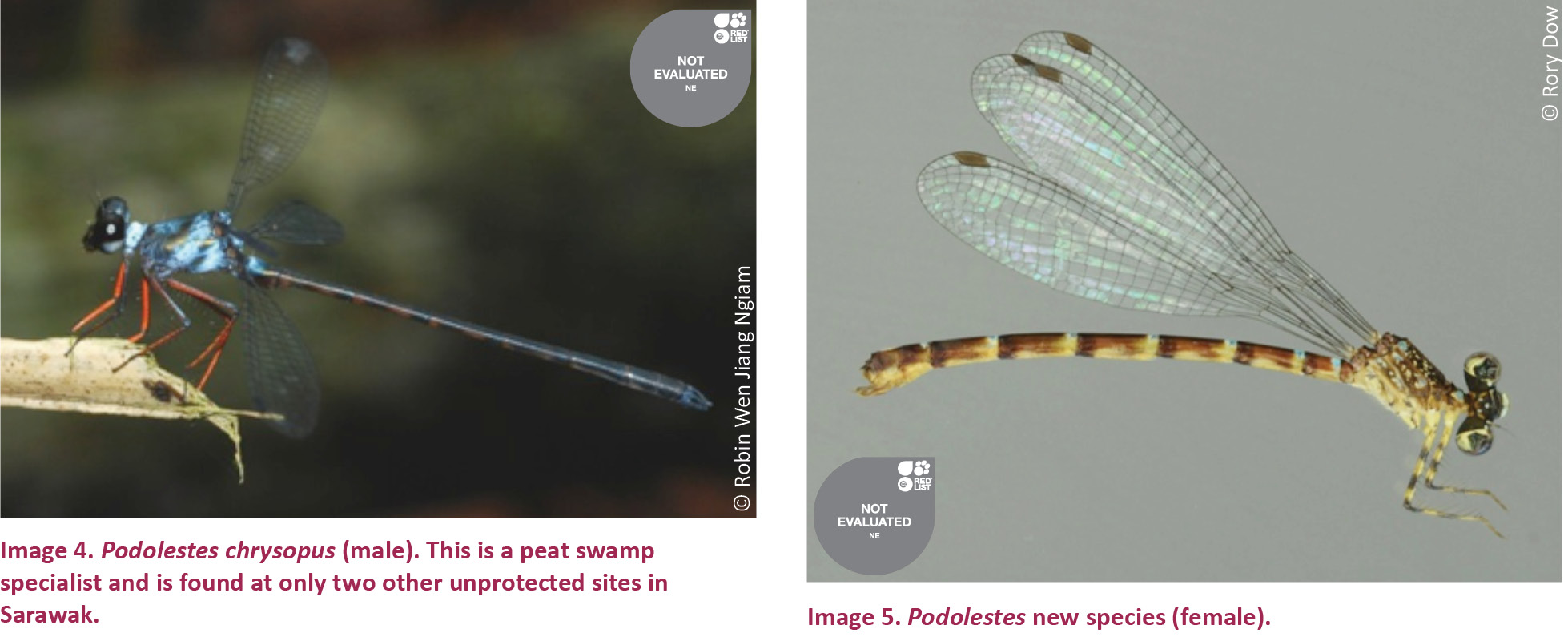
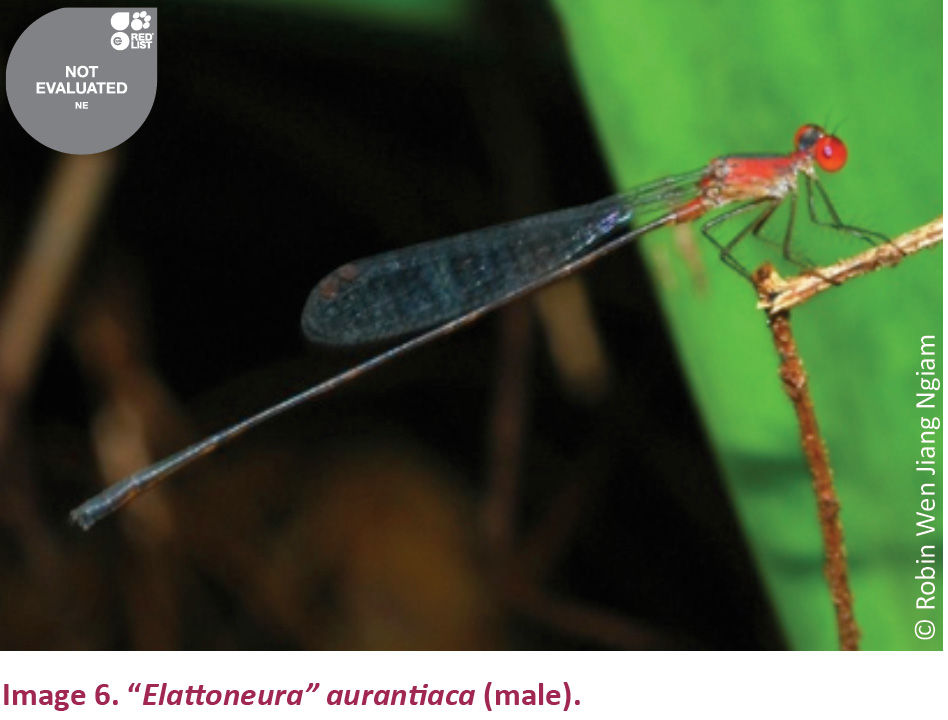
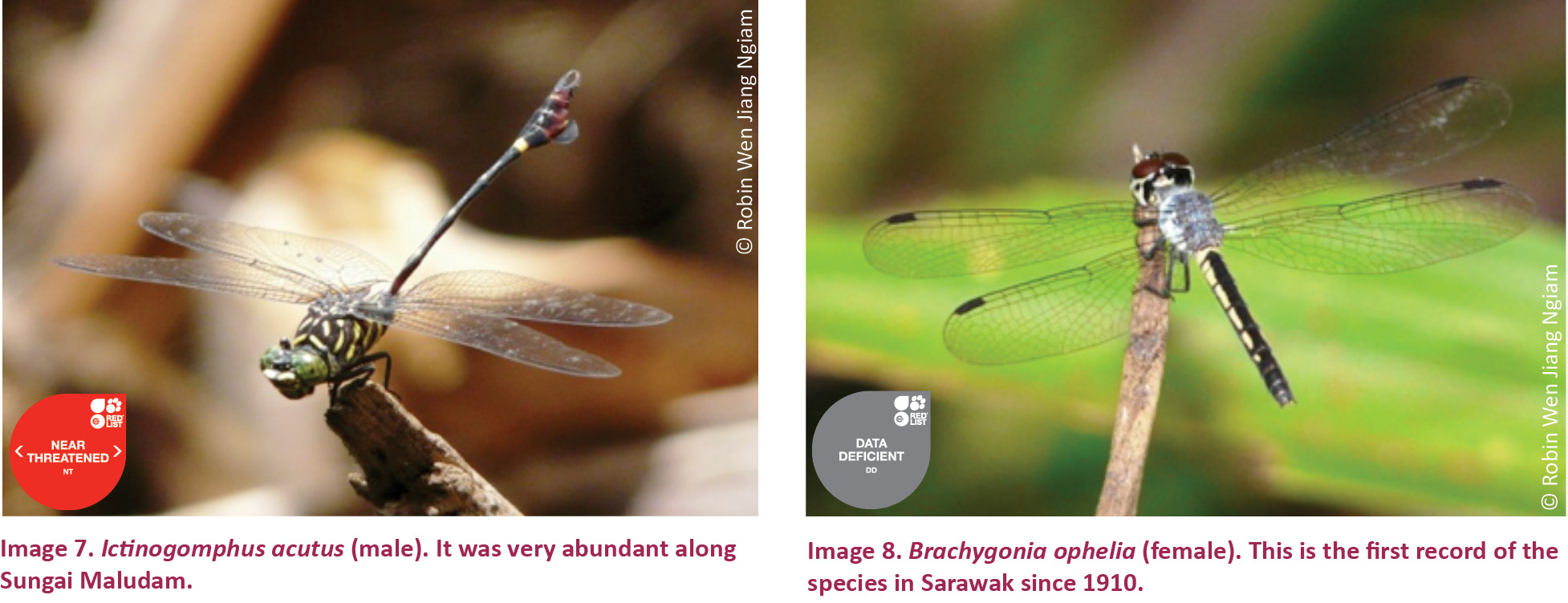
Anisoptera
Aeshnidae
(i) Gynacantha dohrni Krüger, 1899 — 1 male, 7.vii.2012, RD.
(ii) Heliaeschna idae (Brauer, 1865) — This large species was abundant during the sampling period. It is typically regarded as a crepuscular species, but at Maludam it was observed flying all day, even in bright sunlight in parts of the forest where the canopy had been opened extensively by past logging activities. 1 male, 7.vii.2012, RD; 1 male, 7.vii.2012, RN; 1 male, 8.vii.2012, RN; 1 male, 9.vii.2012, RD; 1 male, 1 female, 10.vii.2012, WA; 1 male, 1 female (in tandem), 10.vii.2012, RD; 1 male, 10.vii.2012, RN.
(iii) Oligoaeschna foliacea Lieftinck, 1968 — 1 male, 2 females, 11.vii.2012, RD.
(iv) Tetracanthagyna plagiata (Waterhouse, 1877) — 1 female, 9.vii.2012, RD.
Gomphidae
(i) Ictinogomphus acutus (Laidlaw, 1914) (Image 7) — 4 males, 2 females, 6.vii.2012, RD; 2 males, 6.vii.2012, RN; 1 male, 7.vii.2012, RD; 2 males, 7.vii.2012, RN; 1 female, 9.vii.2012, RN; 1 male, 11.vii.2012, WA; 2 males, 11.vii.2012, RN.
(ii) Ictinogomphus decoratus melaenops (Selys, 1858) — 1 male, 7.vii.2012, RN; 1 male, 9.vii.2010, RD.
(iii) Macrogomphus decemlineatus (Selys, 1878) — We are not aware of any published record of this species having been collected in Sarawak since that in Laidlaw (1914) of two males collected from “Kuching” in May 1896. The species is known from Borneo, Sumatra, Belitung and peninsular Malaysia, but is seldom recorded. 2 males, 6.vii.2012, RD.
Macromiidae
(i) Macromia cincta Rambur, 1842 — 1 male, 9.vii.2012, RN; 1 male, 10.vii.2012, WA; 1 male, 10.vii.2012, RD.
Corduliidae
(i) Hemicordulia tenera Lieftinck, 1930 — 1 male, 6.vii.2012, RD; 2 males, 7.vii.2012, RD; 5 males, 1 female (in tandem), 7.vii.2012, RN; 1 male, 8.vii.2012, WA; 1 male, 9.vii.2012, RN; 6 males, 10.vii.2012, WA; 1 male, 10.vii.2012, RN; 1 male, 11.vii.2012, RD.
Libellulidae
(i) Brachygonia oculata (Brauer, 1878) — 1 male, 6.vii.2012, RD; 1 male, 1 female, 6.vii.2012, RN; 1 male, 7.vii.2012, RD; 1 male, 1 female, 7.vii.2012, RN; 2 males, 2 females, 8.vii.2012, WA; 1 male, 8.vii.2012, RN; 3 females, 9.vii.2012, WA; 1 male, 9.vii.2012, WA; 1 female, 9.vii.2012, RN; 1 male, 2 females, 10.vii.2012, WA; 1 male, 10.vii.2012, RN; 1 female, 11.vii.2012, WA.
(ii) Brachygonia ophelia Ris, 1910 (Image 8) — The last published record of this species from Sarawak was made in Kuching Division in 1910 (Laidlaw 1920), making this the first record of the species from the state for more than 100 years. It is a locally occurring specialist of low pH swamp forest, known to occur across Borneo and in peninsular Malaysia, but with very few records. 1 male, 9.vii.2012, RN; 1 female, 11.vii.2012, RN.
(iii) Brachygonia puella Lieftinck, 1937 — Maludam National Park is the second site in Sarawak where this poorly known species has been found; the other site is Binyo Penyilam proposed national park in Bintulu Division (Dow & Unggang 2010). It is also known from Kalimantan Tengah and Belitung. 3 males, 6.vii.2012, RD; 2 males, 6.vii.2012, RN; 2 males, 8.vii.2012, WA; 2 males, 8.vii.2012, RN; 1 male, 9.vii.2012, WA; 2 males, 10.vii.2012, WA; 1 male, 10.vii.2012, RD.
(iv) Chalybeothemis fluviatilis Lieftinck, 1933 — 2 males, 6.vii.2012, RD; 2 males, 6.vii.2012, RN; 1 male, 10.vii.2012, RD; 1 male, 11.vii.2012, RD; 3 males, 11.vii.2012, RN.
(v) Nannophya pygmaea Rambur, 1842 — 1 male, 6.vii.2012, RD; 1 male, 6.vii.2012, RN; 2 males, 10.vii.2012, WA.
(vi) Neurothemis fluctuans (Fabricius, 1793) — 1 male, 11.vii.2012, RD.
(vii) Orchithemis pruinans (Selys, 1878) — 1 male, 10.vii.2012, RN.
(viii) Orchithemis pulcherrima Brauer, 1878 — 1 male, 10.vii.2012, RN.
(ix) Orchithemis xanthosoma Laidlaw, 1911 — 2 males, 1 female, 7.vii.2012, RD; 3 males, 7.vii.2012, RN; 1 male, 8.vii.2012, WA; 1 male, 9.vii.2012, RD; 1 male, 9.vii.2012, RN; 1 male, 10.vii.2012, RD; 1 male, 11.vii.2012, RN.
(x) Orthetrum chrysis (Selys, 1891) — 1 male, 8.vii.2012, WA;
(xi) Orthetrum sabina (Drury, 1773) — 1 male, 6.vii.2012, RN.
(xii) Pornothemis serrata Krüger, 1902 — 1 male, 6.vii.2012, RD; 2 males, 6.vii.2012, RN; 1 female, 7.vii.2012, RD; 1 male, 9.vii.2012, RD; 1 male, 10.vii.2012, RD.
(xiii) Rhodothemis rufa (Rambur, 1842) — 1 male, 7.vii.2012, RN.
(xiv) Rhyothemis fulgens Kirby, 1889 — This species was treated as a junior synonym of R. pgymaea (Brauer, 1867) by Ris (1913), a course followed by almost all subsequent authors, but is clearly distinct from true R. pygmaea, differing substantially in the male anal appendages; it appears that R. pygmaea occurs east of the Wallace line and that all records from west of the Wallace line actually refer to R. fulgens. This subject will be treated in detail elsewhere (Dow in preparation). 1 male, 6.vii.2012, RN; 1 male, 1 female (in tandem), 7.vii.2012, RN; 1 male, 10.vii.2012, RN.
(xv) Rhyothemis obsolescens Kirby, 1889 — 1 male, 6.vii.2012, RD.
(xvi) Tyriobapta laidlawi Ris, 1919 — 3 males, 6.vii.2012, RD; 1 male, 6.vii.2012, RN; 1 male, 7.vii.2012, RD; 1 male, 7.vii.2012, RN; 2 males, 8.vii.2012, WA; 1 male, 9.vii.2012, WA; 2 males, 1 female, 9.vii.2012, RD; 1 male, 9.vii.2012, RN; 1 male, 1 female, 10.vii.2012, WA; 2 males, 10.vii.2012, RD; 1 male, 10.vii.2012, RN; 2 males, 11.vii.2012, WA.
(xvii) Urothemis signata insignata (Selys, 1872) — 2 males, 1 female, 6.vii.2012, RD; 1 female, 6.vii.2012, RN; 1 male, 8.vii.2012, WA; 1 male, 11.vii.2012, WA; 1 male, 11.vii.2012, RN.
(xviii) Zyxomma petiolatum Rambur, 1842 — 1 male, 9.vii.2012, RN; 1 male, 10.vii.2012, RD.
DISCUSSION
The results from this first Odonata collection in Maludam National Park are very encouraging, the 48 species recorded offer a snapshot of the diversity present in the park; further surveys will surely uncover additional species. With a number of rare and specialist species, including three previously unknown to science, it is already clear that Maludam National Park is an important area for odonate conservation and research in northern Borneo. One of the new species has already been described in Dow & Ngiam (2013). Only a single male specimen of this species, Prodasineura yulan, was collected. Description of the other two new species (Podolestes new species cf. atomarius and Ceriagrion new species) is in preparation. Besides the new species found, other important records were also made, including only the second record in Sarawak for Pachycypha aurea and Brachygonia puella, and the first record in Sarawak for over 100 years for Macrogomphus decemlineatus and Brachygonia ophelia. Due to time constraints and low water levels, the upper reaches of Ulu Maludam, where there are more pristine forest areas, were not explored; this is a priority area for future work.
Species collected at Maludam National Park and considered to be worthy of special attention from a conservation viewpoint, at least in Sarawak, are summarised in Table 1. For explanation of terms such as Data Deficient, Area of Occurrence etc., see IUCN (2012). There is still insufficient data to make concrete statements about the rarity or otherwise of many odonate species in Sarawak. However, any peat swamp forest specialist species confined to Borneo can be reasonably assumed to be of serious conservation concern, as peat swamp forest is undoubtedly an extremely threatened forest type in South-east Asia, known to have undergone a serious and continuing decline in its extent, and in the quality of what remains (e.g. Wong 2013, Posa et al. 2011); probably the only truly pristine peat swamp habitats remaining on the island are in Brunei. Moreover, as very little peat swamp forest is protected in Sarawak, peat swamp specialist species occurring in the state have few secure refuges and are of significant conservation concern.
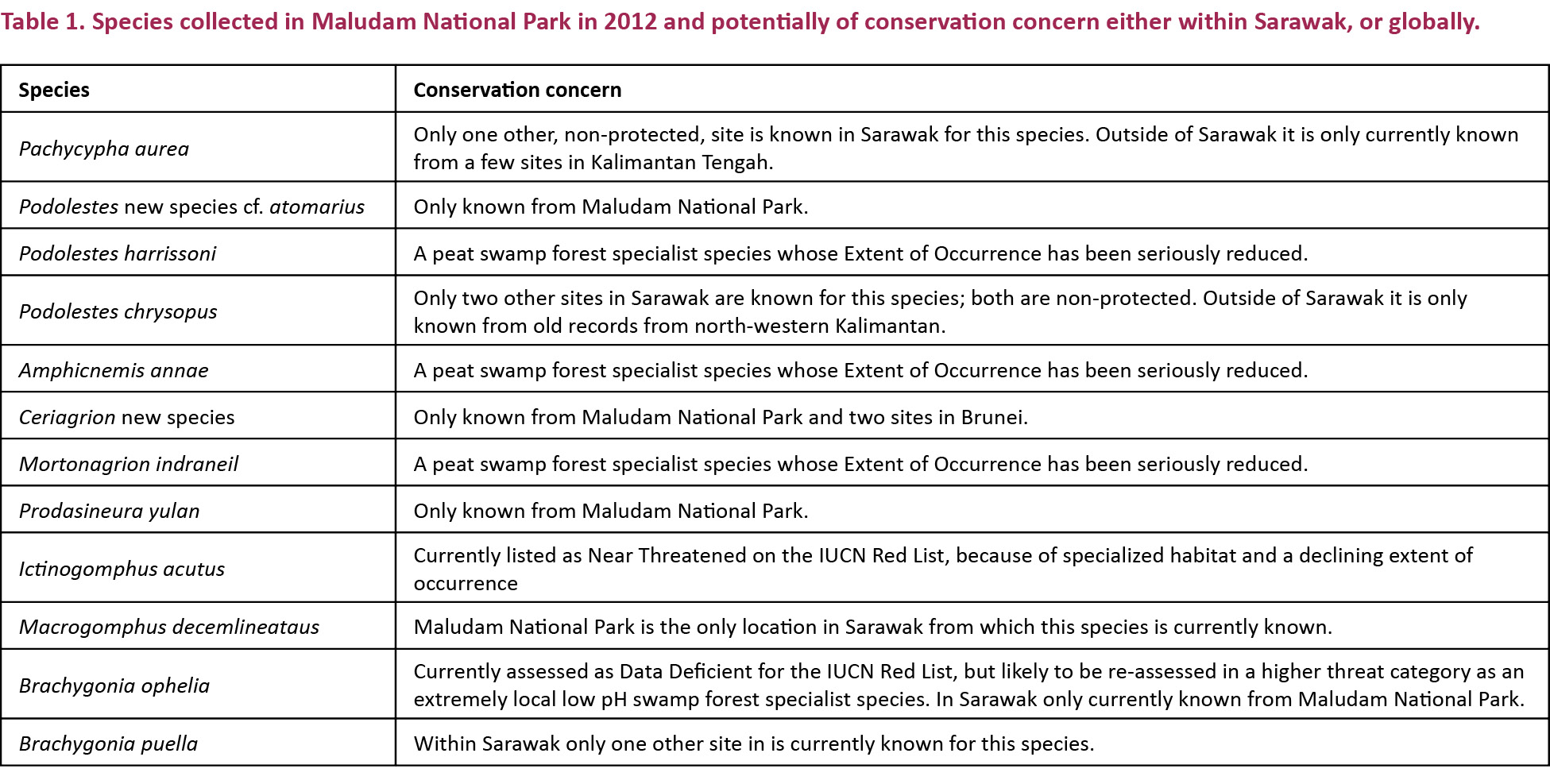
There are relatively few publications dealing specifically with the Odonata of peat swamp forest and other low pH swamp forest formations in Borneo. Orr (2001) includes records from peat swamp forest in Belait district of western Brunei, as do Thompson & van Tol (1993). Considerable extra data from peat swamp forest in northern Belait District was generated in 2013 as part of the Belait Biodiversity Action Plan project (Dow & Choong unpublished); this data will be published in due course. Dow & Silvius (2014) deals with the peat swamp forests of Central Kalimantan, Indonesian Borneo; many records in Lieftinck (1953a,b) must actually be from similar habitat, but details are lacking. Yagi & Kitagawa (2001) presented records from degraded peat swamp forest in the Klias peninsula on the west coast of Sabah. For Sarawak, Dow & Unggang (2010) discussed the odonate fauna of low pH swamp forest at Binyo Penyilam in Bintulu Division, Dow & Reels (2011) presented records from a peat swamp forest remnant in Kuching Division, and Dow & Reels (2013) includes records from Sama Jaya Nature Reserve in Kuching Division (where the habitat may be best characterized as kerapa – intermediate between peat swamp and kerangas forest), from peat swamp forest at the Universiti Malaysia Sarawak campus in Samarahan Division, and a few records from extremely disturbed peat swamp forest from the Simunjan area further west in the same administrative division. As-yet-unpublished data is also available from Loagan Bunut National Park in Miri Division, and from highly disturbed peat swamp forest habitats in the vicinity of Marudi in the lower Baram area of the same division. In Sundaland outside of Borneo substantial areas of peat swamp forest occur in Sumatra and, to a lesser extent, in peninsular Malaysia; for these areas even less data is available. We are not aware of any publications dealing specifically with peat swamp forest Odonata from Sumatra or its satellite islands; although some records from Sumatra and Belitung must be from peat swamp forest, but details of habitat are lacking from most records. From peninsular Malaysia data from peat swamp forest can be found in Choong & Cheah (2013: Ayer Hitam in Johor), Dow et al. (2010, 2012: the Sungai Bebar area in Pahang) and Norma Rashid et al. (2001: Tasek Bera in Pahang; most records in this publication appear to be from open habitats around the margin of the lake Tasek Bera rather than from within the peat swamp forest that borders part of the lake).
Although there is an urgent need for far more data from the remaining peat swamp forest areas of Borneo, sufficient data is now available to make some preliminary observations about the specialist odonate fauna of peat swamp forest of different parts of the island.
For Anisoptera the available data suggests that many of the specialist species have relatively large ranges, some even extending beyond Borneo. However some of the more widely distributed species, perhaps most notably Brachygonia ophelia, are extremely local in occurrence. We are not aware of any specialist anisopteran species confined to peat swamp forest in just one part of Borneo. However it should be noted that many species from the families Aeshnidae, Gomphidae, Macromiidae and Corduliidae are so difficult to sample in Borneo that it is entirely possible that some restricted range peat swamp specialists have not yet been detected.
For the more weakly flying Zygoptera the situation is very different. In genera generally recognized as having many swamp forest specialist species, e.g., Podolestes, Amphicnemis and Mortonagrion, all the peat swamp specialist species found in Borneo are endemic to the island. Additionally the available evidence suggests that a number of the Bornean Platycnemididae formerly placed in Protoneuridae, e.g., members of Elattoneura sensu lato and Prodasineura, are specialists of low pH streams; of these only “Elattoneura” (sic) aurantiaca and “Elattoneura” (sic) coomansi Lieftinck, 1937 are known to occur outside of Borneo.
Within Borneo many of the peat swamp specialist Zygoptera appear to have restricted ranges. Most of the Zygoptera known or believed likely to be peat swamp or other low pH swamp forest specialists occurring in Central Kalimantan appear to be confined to the peat lands of southern Borneo (See Dow & Silvius (2014) and Dow (2014): Podolestes atomarius Lieftinck, 1950; P. furcifer Lieftinck, 1950; Coeliccia new species; “Elattoneura” erythromma Lieftinck, 1953; Prodasineura abbreviata Lieftinck, 1951; P. quadristigma Lieftinck, 1951; Prodasineura new species; Amphicnemis erminea Lieftinck, 1953; A. pandanicola Lieftinck, 1953; A. platystyla Lieftinck, 1953; Amphicnemis triplex Dow, 2014 and an as-yet-un-named Amphicnemis species). As these low lying areas are almost isolated from similar habitats in other parts of the island by extensive mountain ranges, the high degree of endemicity to the region may not be surprising. However even in northern Borneo, many peat swamp specialist species appear to have small ranges. Amphicnemis madelenae Laidlaw, 1913 is only known from northwestern Kalimantan (Lieftinck 1954) and Kuching Division in Sarawak (e.g., Dow & Reels 2011, 2013). The status of a number of forms allied to A. martini Ris, 1911 is unclear, but some may be distinct species with small ranges; at least one of these is a peat swamp specialist. An unnamed peat swamp species of Coeliccia known from two sites in Kuching and Samarahan divisions (Dow & Reels 2011, 2013) has not been found at Maludam or further east, while Coeliccia macrostigma Laidlaw, 1918 is a peat swamp forest specialist only known from the lower Baram area (where virtually no suitable habitat remains) and Belait District in Brunei. Two of the new species found at Maludam (Podolestes new species and Prodasineura yulan) have not been found anywhere else. Podolestes chrysopus is only reliably known from north-west Kalimantan and Sarawak as far east as Maludam. However, Pachycypha aurea, which is a peat swamp forest specialist, appears to have a wide distribution from Kalimantan Tengah to western Sarawak. We can tentatively conclude that there is a “hot spot” for peat swamp Zygoptera endemicity and diversity in southern Kalimantan and possibly another in northwestern Kalimantan and southwestern Sarawak. What appears certain is that additional peat swamp specialist species remain undiscovered in the many poorly sampled parts of the lowlands of Borneo. As very little peat swamp forest has totally protected status in Borneo, many of the peat swamp specialist Odonata face an uncertain future.
REFERENCES
Choong, C.Y. & D.S. Cheah (2013). Odonata of Ayer Hitam Forest Reserve, Johor, Peninsular Malaysia. Faunistic Studies in South-East Asian and Pacific Island Odonata 2: 1–11.
Dijkstra, K.D.B., G. Bechly, S.M. Bybee, R.A. Dow, H.J. Dumont, G. Fleck, R.W. Garrison, M. Hämäläinen, V.J. Kalkman, H. Karube, M.L. May, A.G. Orr, D.R. Paulson, A.C. Rehn, G. Theischinger, J.W.H. Trueman, J. van Tol, N. von Ellenrieder & J. Ware (2013). The classification and diversity of dragonflies and damselflies (Odonata). In: Zhang, Z.Q. (ed.). Animal biodiversity: An outline of higher-level classification and survey of taxonomic richness (Addenda 2013). Zootaxa 3703: 1–82; http://dx.doi.org/10.11646/zootaxa.3703.1.9
Dijkstra, K.-D.B., V.J. Kalkman, R.A. Dow, F.R. Stokvis & J. van Tol (2014). Redefining the damselfly families: the first comprehensive molecular phylogeny of Zygoptera (Odonata). Systematic Entomology 39(1): 68–96; http://dx.doi.org/10.1111/syen.12035
Dow, R.A. (2012). Odonata collected at Gunung Pueh, Kuching Division, Sarawak, Malaysia in October 2012. International Dragonfly Fund Report 54: 1–21.
Dow, R.A. (2014). Amphicnemis triplex sp. nov. from Central Kalimantan, Indonesia (Odonata: Coenagrionidae). Odonatologica 43(1/2): 67–77.
Dow, R.A., C.Y. Choong & Y.F. Ng (2010). A review of the genus Amphicnmemis in Peninsular Malaysia and Singapore, with descriptions of two new species (Odonata: Zygoptera: Coenagrionidae). Zootaxa 2605: 45–55.
Dow, R.A., Y.F. Ng & C.Y. Choong (2012). Odonata of Sungai Bebar, Pahang, Malaysia, with four species recorded for the first time from mainland Asia. Journal of Threatened Taxa 4(3): 2417–2426; http://dx.doi.org/10.11609/JoTT.o3041.2417–26
Dow, R.A. & R.W.J. Ngiam (2013). Prodasineura yulan (Odonata: Zygoptera: Platycnemididae), a new species from Sarawak. Zootaxa 3670(1): 87–90; http://dx.doi.org/10.11646/zootaxa.3670.1.8
Dow, R.A. & G.T. Reels (2011). Odonata from a remnant patch of disturbed peatswamp forest on the outskirts of Kuching, west Sarawak. Agrion 15(2): 50–51.
Dow, R.A. & G.T. Reels (2013). Previously unpublished Odonata records from Sarawak, Borneo. Part I. Kuching Division excluding Kubah National Park, and Samarahan Division. Faunistic Studies in South-East Asian and Pacific Island Odonata 3: 1–25.
Dow, R.A. & M. Silvius (2014). Results of an Odonata survey carried out in the peatlands of Central Kalimantan, Indonesia, in 2012. Faunistic Studies in South-East Asian and Pacific Island Odonata 7: 1–37.
Dow, R.A. & J. Unggang (2010). The Odonata of Binyo Penyilam, a unique tropical wetland area in Bintulu Division, Sarawak, Malaysia. Journal of Threatened Taxa 2(13): 1349–1358; http://dx.doi.org/10.11609/JoTT.o2478.1349-58
Hazebroek, H.P. & A.K.A. Morshidi (2000). National Parks of Sarawak. Natural History Publications (Borneo), Malaysia, 502pp.
IUCN (2012). IUCN Red List Categories and Criteria: Version 3.1. Second edition. Gland, Switzerland and Cambridge, UK: IUCN, iv+32pp.
Kalkman, V.J. & G. Theischinger (2013). Generic revision of Argiolestidae (Odonata), with four new genera. International Journal of Odonatology 16(1): 1–52; http://dx.doi.org/10.1080/13887890.2012.749450
Laidlaw, F.F. (1914). Contributions to a Study of the Dragonfly Fauna of Borneo. Part II. The Gomphinae and Chlorogomphinae. Proceedings of the Zoological Society of London, 1914: 51–63, plate I.
Laidlaw, F.F. (1920). Contributions to the study of the dragonfly fauna of Borneo. Part IV. A list of species known to occur in the island. Proceedings of the Zoological Society of London, 1920: 311–342.
Lieftinck, M.A. (1935). New and little known Odonata of the Oriental and Australian Regions. Treubia 15(2): 175–207.
Lieftinck, M.A. (1953a). Additions to the odonate fauna of the Indo-Australian archipelago. Treubia 22(1): 233–269.
Lieftinck, M.A. (1953b). New dragonflies (Odonata) from Borneo, with notes on their habits and larvae. Treubia 22(2): 381–406.
Lieftinck, M.A. (1954). Handlist of Malaysian Odonata. A catalogue of the dragonflies of the Malay Peninsula, Sumatra, Java and Borneo, including the adjacent small islands. Treubia (Suppl.) 22: i–xiii+202pp.
Norma-Rashid, Y., A. Mohd-sofian & M. Zakaria-Ismail (2001). Diversity and distribution of Odonata (dragonflies and damselflies) in the freshwater swamp lake Tasek Bera, Malaysia. Hydrobiologica 459: 135–146.
Orr, A.G. (2001). An annotated checklist of the Odonata of Brunei with ecological notes and descriptions of hitherto unknown males and larvae. International Journal of Odonatology 4(2): 167–220.
Posa, M.R.C, L.S. Wijedasa & R.T. Corlett (2011). Biodiversity and Conservation of Tropical Peat Swamp Forests. BioScience 61(1): 49–57.
Ris, F. (1913). Libellulinen 7. Collections Zoologiques du Baron Edm. De Selys Longchamps. Catalogue Systématique et Descriptif 15: 837–964, plate VII.
Sarawak Foresty Corporation (2013). http://www.sarawakforestry.com/htm/snp-np.html. Accessed 01 December 2013.
Selys Longchamps, E. de (1889). Odonates de Sumatra comprenant les espèces recueillies à Pulo Nias par M. le Dr. E. Modigliani. Annali Museo Civico Storia Naturale Genova 27: 444–484.
Thompson, D.J. & J. van Tol (1993). Damselflies and dragonflies from four forest types in Brunei. Brunei Museum Journal 8: 57–72.
UNDP (2006). Malaysia’s Peat Swamp Forests. Conservation and Sustainable use. United Nations Development Programme (UNDP), Malaysia, iv+33pp.
Wong, J.L.M. (2003). Status of Peat Swamp Forest in Sarawk. Malaysia / The Netherlands Joint Working Group on Sustainable Forest Management. Lee Miing Press Sdn. Bhd. Kuching, Sarawak, Malaysia, 40pp.
Yagi, T. & T. Kitagawa (2001). A survey of the dragonflies in the Klias and Binsulok Forest Reserves, Sabah, Malaysia. Nature and Human Activities 6: 31–39.